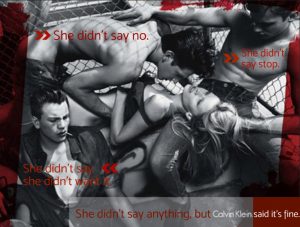Original Ad: Calvin Klein Billboard

For decades, the extensive broadcasting of gendered stereotypes in media and pop culture of women as objects of sexual desire and men as sexually aggressive has normalized rape culture which has severe implications for the safety of women in society. While viral movements like #MeToo and #TimesUp have raised the profile of sexual assault and rape, statistics show 1 in 3 women are at risk of being sexually assaulted during their lifetime (Statistics Canada, 2006). When I say rape culture I am referring to “the complex of beliefs that encourages male sexual aggression and supports violence against women. It is a society where violence is seen as sexy and sexuality as violent” (Rentschler, 2014, pp. 66).
One of the largest contributors to normalizing rape culture are clothing brand advertisements. This controversial Calvin Klein billboard ad for jeans pictured above has been heavily criticized for its suggestions of non-consensual rape fantasy. Two of the men in the ad are in dominant and aggressive positions hovering above the woman who is undressed from the waist down with her shirt pushed up and her eyes closed. She appears to be unconscious and unaware of the sexual advances of the men surrounding her. What’s worse, despite this being an advertisement for jeans, she isn’t wearing any so it’s evident this ad is targeted towards men. One of the men has his pants half off and has the woman pinned beneath him. The second man has one hand pulling the woman’s hair keeping her pinned down. The third man is on the ground with his eyes closed appearing unfazed by the scene unfolding around him, which depicts the group mentality effect that is evident in research of fraternities and gang rape where loyalty to the group can lead to identification with the group’s ethics even over one’s own (Boswell & Spade, 1996). The cage surrounding the scene creates a feeling of entrapment with no escape, adding to the violence of the scene.
In the culture jam, I will be addressing how rape culture validates the normative misogynistic practices that perpetuate toxic masculinity and violence against women. Specifically, I will address how male supremacy and the power and privilege that comes with it reinforces desensitization of rape, sexualization of female bodies, and blurs lines of consent.
Jammed Ad: Calvin Klein Says It’s Fine

I subverted the original image’s message by leveraging the contrast between the men who are visibly conscious compared to the woman who doesn’t appear to be. In the jammed version, I added misconceptions of consent statements on each of the young men saying “she didn’t say no,” “she didn’t say she didn’t want it,” and “she didn’t say stop” while the woman lays motionless saying nothing. My intention for doing this is to highlight how in this male-dominated fantasy of “she wanted it” that is normalized by a patriarchal society it is the men, and not the victim, who is in control of the narrative of consent. In giving the men a voice in the jammed version and not the woman, I wanted to depict how men in positions of power often dismiss, blame or deny the voice of victims.
I also added the line at the bottom “she didn’t say anything at all, but Calvin Klein says it’s fine” to highlight the level of influence colossal brands, media and the criminal justice system have. As an affluential global brand created by a male fashion designer, Calvin Klein saying “it’s fine” to treat women this way is representative of how male supremacy embedded in positions of power like policemen, judges, film, and fashion perpetuates rape eroticization in society and robs victims of their voice.
In the jammed version, I also wanted to draw parallels to how fraternity related rape case verdicts are too often determined by he said/she said statements that favour young men from privileged backgrounds. As in the ad, these young men are in positions of power due to the victim-blaming mentality that is perpetuated by rape culture. Despite the young men in the ad clearly not understanding what consensual cues look like, it is the victim and not them who is systematically silenced.
References
Boswell, A.A., & Spade, J.Z. (1996). Fraternities and collegiate rape culture: why are some fraternities more dangerous places for women? Gender and Society, 10(2), 133–147.
Rentschler, C.A. (2014). Rape culture and the feminist politics of social media. Girlhood Studies, 7(1), 65-82. doi: 10.3167/ghs.2014.070106
Statistics Canada (2006) Prevalence and severity of violence against women. Retrieved June 26, 2018 from https://www150.statcan.gc.ca/n1/pub/85-570-x/2006001/findings-resultats/4144393-eng.htm